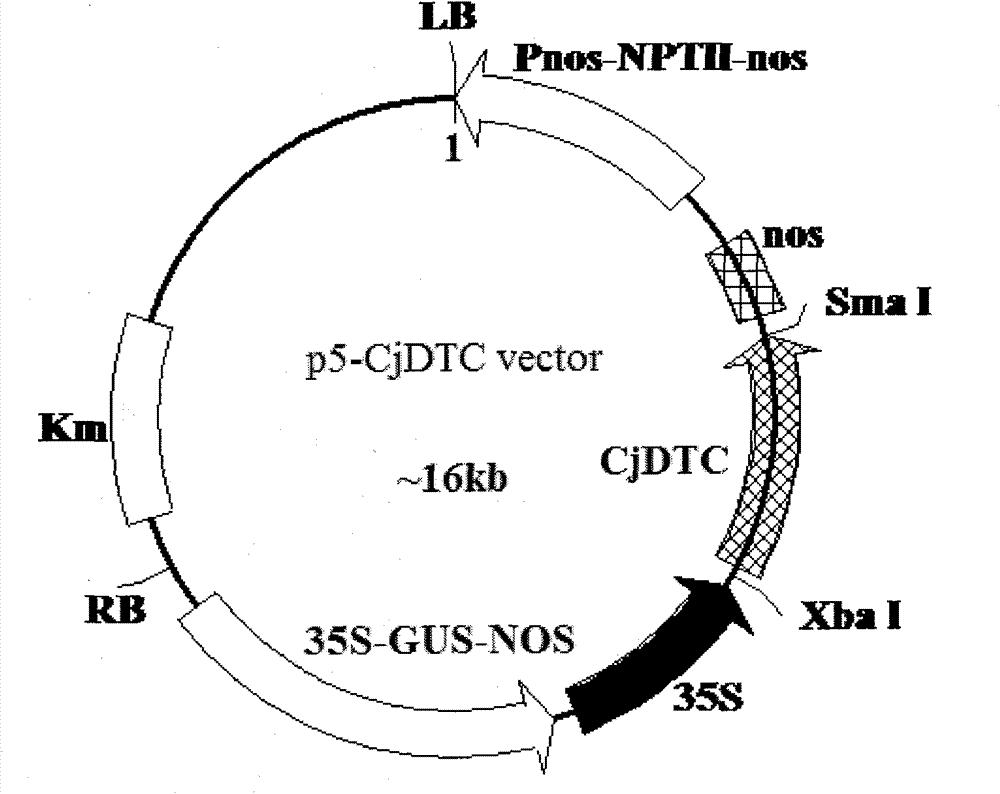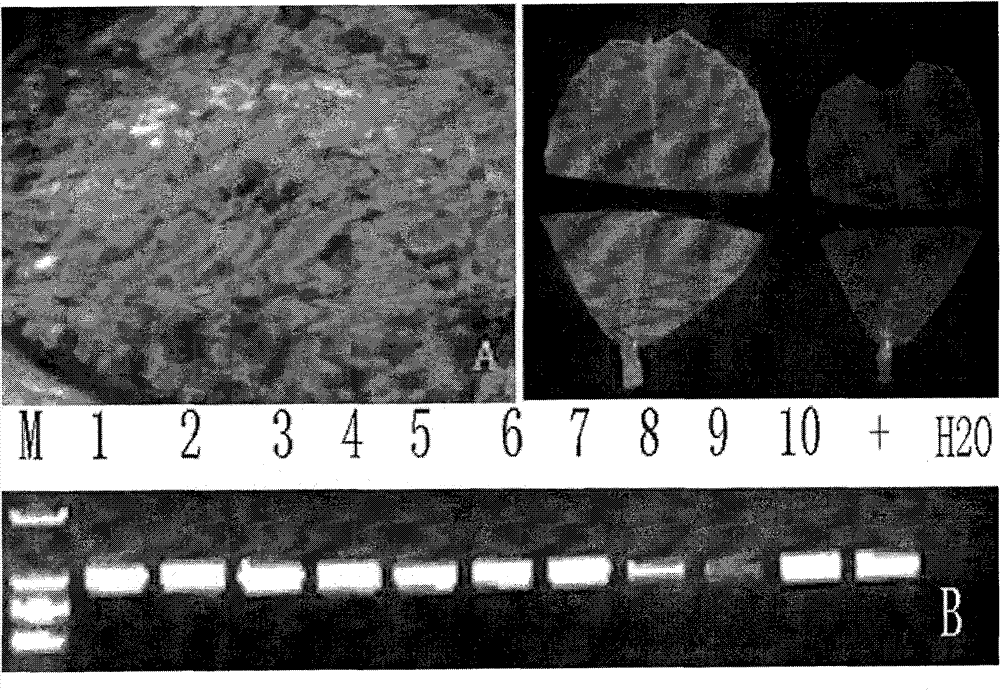Plant expression vector for expressing dicarboxylate-tricarboxylate carrier (DTC) genes and application thereof in improving aluminum-resistant performance of Medicago sativa L
A transporter and transgenic technology, which is applied in the field of plant genetic engineering to achieve the effects of increased root elongation, huge economic benefits, and improved aluminum tolerance traits of alfalfa
- Summary
- Abstract
- Description
- Claims
- Application Information
AI Technical Summary
Problems solved by technology
Method used
Image
Examples
Embodiment 1
[0044] The preparation of embodiment one alfalfa genome
[0045] 1. Extraction of DNA
[0046] Select 0.5-1 g of young alfalfa leaves, quickly grind them into powder in liquid nitrogen, add 3 mL of 65°C preheated CTAB extract (100 mmol / L Tris-HCl (pH8.0), 20 mmol / L EDTA (pH8.0), 1.5mol / L NaCl, 2% CTAB (W / V), 4% PVP40 (W / V) and 2% mercaptoethanol (V / V), add PVP and mercaptoethanol before use), shake and mix quickly. Bath at 65°C for 30min, then add 1mL of 5mol / L KAc, ice-bath for 20min, extract once with an equal volume of chloroform:isoamyl alcohol (24:1) (10,000r / min, centrifuge at 4°C for 5min), and take the To clean it, add 2 / 3 times the volume of -20°C pre-cooled isopropanol, mix well, and let it stand for about 30 minutes. Rinse once, blow dry, and resuspend in 500 μL TE. Add 1 μL RNaseA (10mg / ml), and treat at 37°C for 1h. Then phenol (pH8.0): chloroform: isoamyl alcohol (25:24:1) and chloroform: isoamyl alcohol (24:1) were extracted once each (10,000r / min, centrifug...
Embodiment 2
[0059] Embodiment two expresses the nucleotide of carboxylic acid transporter gene and the preparation of plant expression vector
[0060] Bacterial strains containing the pUC-CjDTC cloning vector containing the CjDTC coding gene sequence and the plant expression vector p5 (~500ng) were incubated in 5mL LB liquid medium (containing corresponding antibiotics) at 37°C for 12-16 hours with shaking. Vector construction process see figure 1 . The constructed plant expression vector structure is as follows figure 2 As shown, it includes the nucleotide (SEQ ID NO. 1) for expressing the carboxylic acid transporter gene and each element required for expression screening. pUC-CjDTC is a common cloning vector containing the target gene, and p5 is a backbone vector for constructing plant expression vectors. The p5 vector is modified on the basis of pBI121, and has the GUS gene under the control of the CaMV 35S promoter, which facilitates the process of genetic transformation in plants ...
Embodiment 3
[0068] Preparation of embodiment three transformants and transgenic plants
[0069] 1. Introduce the constructed plant expression vector plasmid into Agrobacterium LBA4404 by electric shock method
[0070] Referring to the Bio-RAD MicroPulser user manual, the above-mentioned vectors were introduced into Agrobacterium LBA4404 by electric shock transformation.
[0071] 2. The vector for overexpressing the CjDTC gene was integrated into the alfalfa genome
[0072] Genetic transformation of alfalfa by an Agrobacterium tumefaciens mediated approach.
[0073] Table 1 Agrobacterium tumefaciens-mediated alfalfa genetic transformation medium formula
[0074]
[0075] MS: Murashige & Skoog, 1962; Gelrite: Sigma, Item No.: G1910; SH: Schenk & Hildebrandt, 1972
[0076] 3. The expression vector is introduced into alfalfa through the method of Agrobacterium-mediated embryogenic healing, and the specific method is as follows:
[0077] (1) Generation of sterile seedlings
[0078] The...
PUM
 Login to View More
Login to View More Abstract
Description
Claims
Application Information
 Login to View More
Login to View More - R&D
- Intellectual Property
- Life Sciences
- Materials
- Tech Scout
- Unparalleled Data Quality
- Higher Quality Content
- 60% Fewer Hallucinations
Browse by: Latest US Patents, China's latest patents, Technical Efficacy Thesaurus, Application Domain, Technology Topic, Popular Technical Reports.
© 2025 PatSnap. All rights reserved.Legal|Privacy policy|Modern Slavery Act Transparency Statement|Sitemap|About US| Contact US: help@patsnap.com



